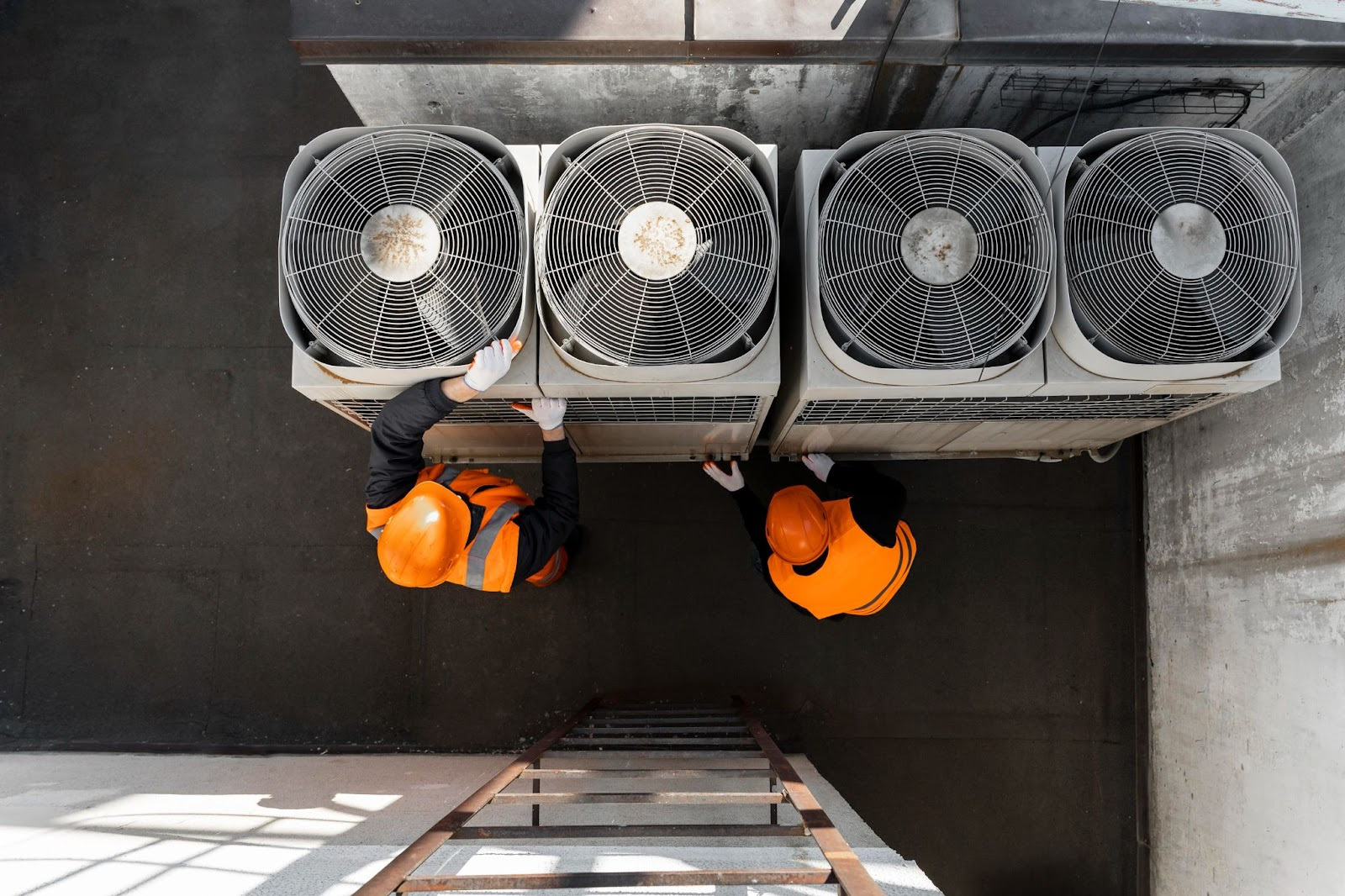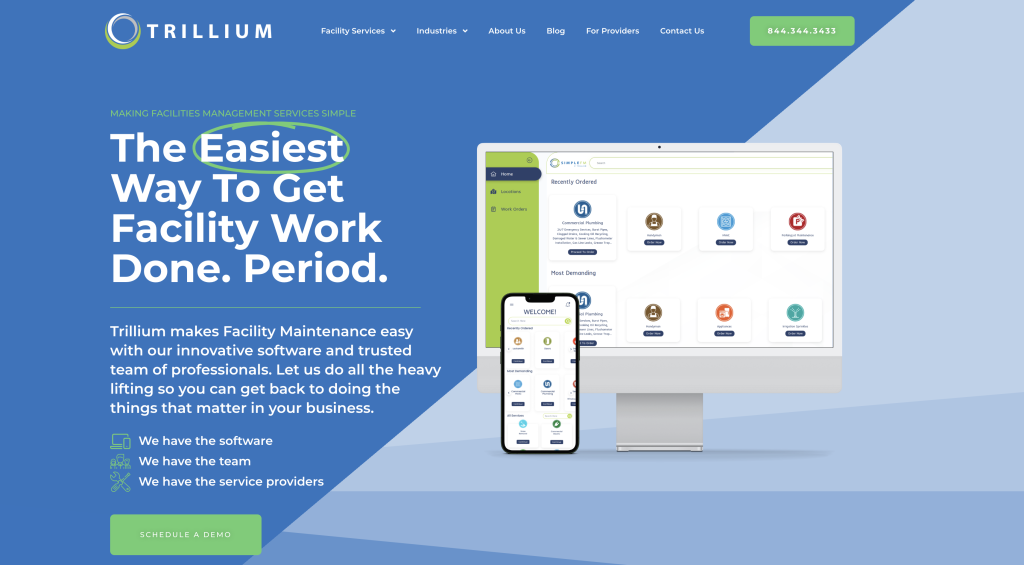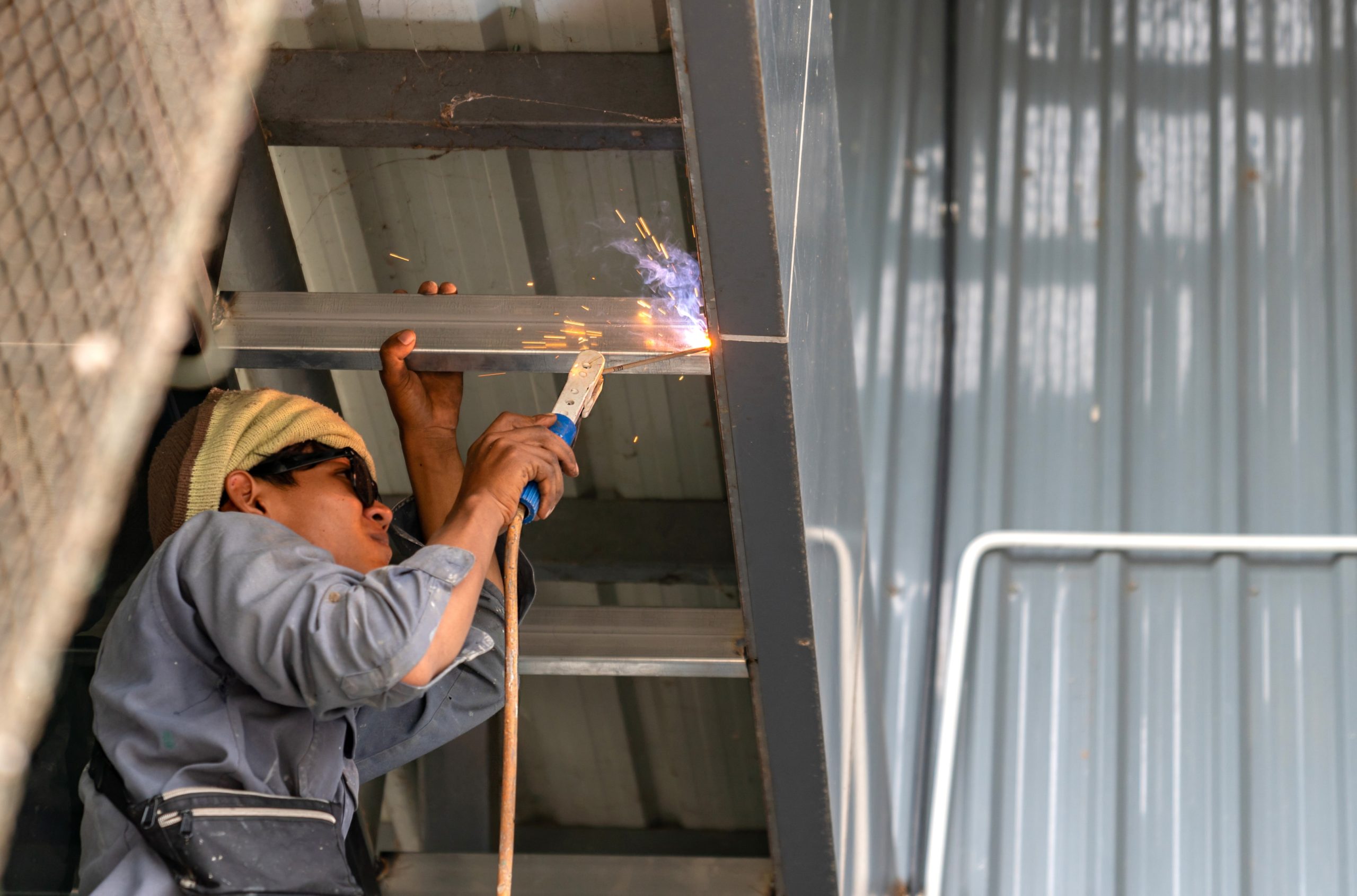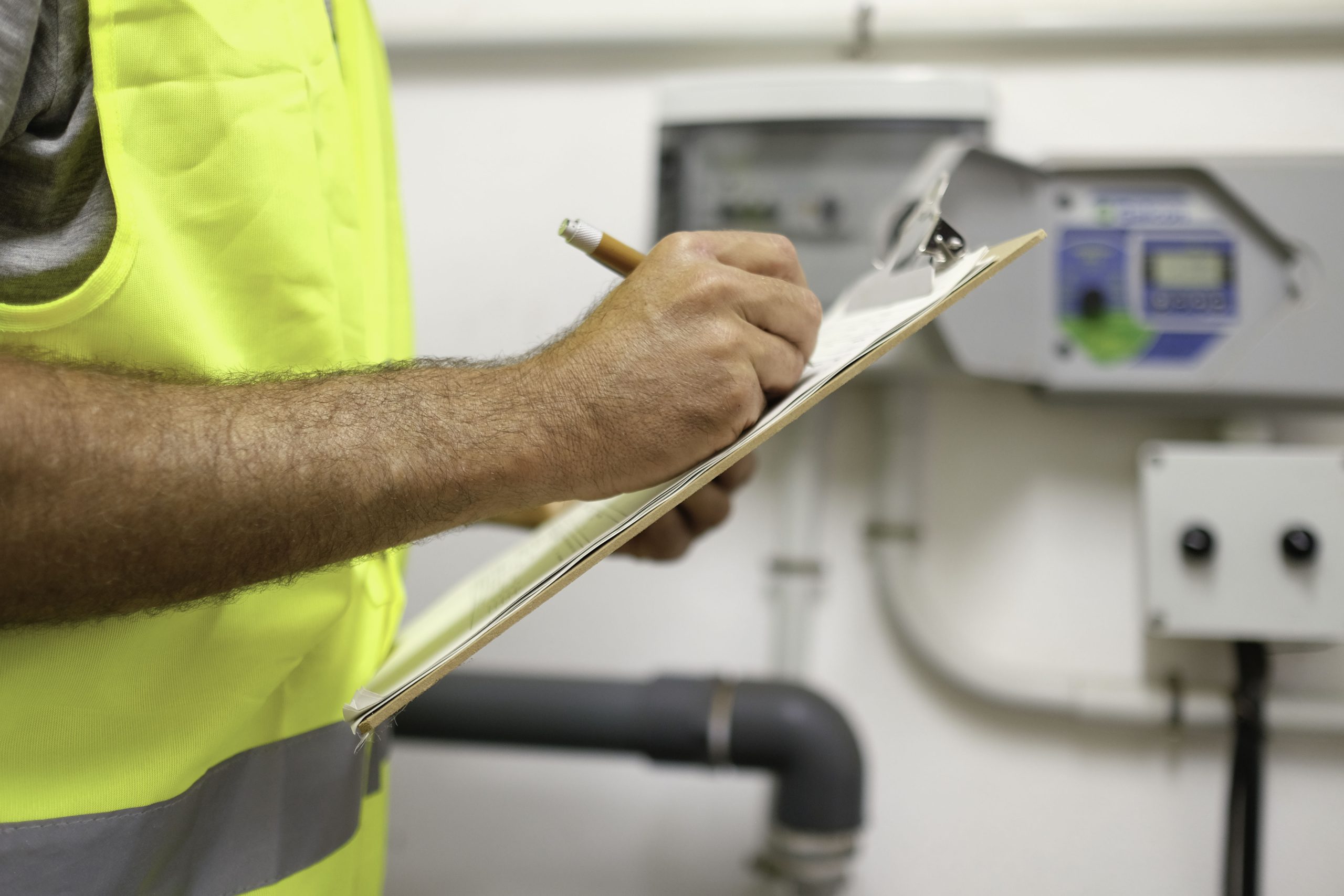HVAC system preventive maintenance shouldn’t be complicated, but neglecting it can lead to expensive repairs, higher energy costs, and an uncomfortable workspace. No one wants to deal with an air conditioning unit failing in the middle of summer or a heating system giving out when temperatures drop.
Fortunately, a little upkeep can prevent most HVAC issues before they start. Following a clear HVAC preventive maintenance checklist keeps your system efficient, extends its lifespan, and helps you avoid last-minute emergencies.
This checklist lays out exactly what needs to be done and when so you can avoid unnecessary repairs and keep your air conditioning system in top shape.
Monthly Commercial HVAC Maintenance Tasks
A few simple checks each month can maintain HVAC systems and prevent bigger problems. When dust, debris, or worn-out parts start piling up, efficiency takes a hit, and problems pile up fast.
Here’s what to stay on top of every month:
- Check and replace air filters: A dirty filter makes your system work harder than it should, driving up energy costs and reducing airflow. Swapping it out regularly keeps everything running smoothly. This frequency changes based on property conditions, but it’s typically a quarterly task.
- Inspect thermostat settings: If the temperature isn’t right, your system could be cycling too often or running when it doesn’t need to. A quick check prevents unnecessary wear and tear.
- Listen for unusual noises: Grinding, rattling, or buzzing sounds can mean loose parts, electrical issues, or motor problems. Catching them early saves you from bigger repairs later.
- Make sure vents and registers aren’t blocked: Blocked airflow forces your system to work harder, leading to uneven temperatures and higher energy bills. A quick walkthrough of your building can fix this in minutes.
- Check condensate drain lines: If these clog up, you could be dealing with water damage, mold, or a system shutdown. Clearing them regularly keeps moisture outside.
These preventive maintenance tasks only take a few minutes but go a long way in preventing breakdowns.
Quarterly Commercial HVAC Maintenance Tasks
Some maintenance tasks don’t have to be done every month, but waiting a full year is asking for trouble. Every three months, a deeper check helps catch small issues before they turn into expensive repairs.
Here’s what needs attention every quarter:
- Clean the condenser and evaporator coils: Dirty coils make it harder for your system to transfer heat, which means higher energy bills and extra strain on the equipment.
- Check refrigerant levels: Low refrigerant leads to poor cooling and potential system damage. If levels are off, there may be a leak that needs fixing before it gets worse.
- Inspect and tighten electrical connections: Loose or frayed wires can lead to system failures or even fire hazards. A quick inspection makes sure everything is secure.
- Lubricate moving parts: Motors, bearings, and belts need proper lubrication to reduce friction and prevent wear. Ignoring this can lead to overheating and breakdowns.
- Ensure proper airflow through ductwork: Dust, debris, and blockages force your system to work harder. Checking for obstructions helps maintain consistent temperatures throughout the building.
Quarterly maintenance helps keep your system running at peak efficiency. As the weather shifts, your HVAC system requires proper upkeep to handle changing temperatures. That’s where seasonal maintenance comes in.
Seasonal HVAC Maintenance Tasks for Commercial Buildings
As temperatures change, your HVAC system works harder to keep up. If it isn’t prepared, efficiency drops, energy bills rise, and breakdowns become more likely. A few maintenance steps before peak heating and cooling seasons can prevent costly issues.
Spring & Summer (Cooling System Prep)
No one wants an air conditioner to quit on the hottest day of the year. Cleaning cooling towers, chillers, and coils keeps the system from overworking and struggling to keep things cool. Checking refrigerant levels helps catch leaks early, so you don’t end up with weak airflow and rising temperatures.
Running efficiency tests now can save you from expensive repairs later. Thermostat calibration also matters since an inaccurate reading can lead to uneven cooling and wasted energy.
Fall & Winter (Heating System Prep)
A heating system failure in the middle of winter is the last thing you need. Heat exchangers need to be checked for cracks or corrosion since damage can lead to dangerous carbon monoxide leaks. Burners, ignition systems, and gas pressure need testing so the system produces steady heat when needed.
Swapping out furnace filters keeps airflow strong and prevents the system from overworking. You also need to do a flue system inspection in buildings with gas heating. This will confirm that ventilation is working properly and that exhaust gases are safely removed.
If your building uses a heat pump, it should be inspected for proper operation and defrost cycles to prevent efficiency loss in colder temperatures.
Seasonal maintenance helps HVAC systems handle extreme temperatures without breaking down.
Annual Commercial HVAC Maintenance Tasks

Some maintenance tasks can wait, but skipping a yearly inspection leads to bigger problems. Over time, parts wear down, energy use creeps up, and minor issues turn into expensive repairs. A thorough check once a year keeps the system efficient and prevents unexpected failures.
A full system inspection catches leaks, worn-out components, and efficiency problems before they cause trouble. Ductwork should be cleaned and checked for leaks since even small gaps waste energy and drive up costs. Running performance tests under peak conditions shows if the system can handle extreme temperatures without struggling.
Safety checks matter just as much as performance. Electrical connections need tightening to prevent malfunctions, and gas-powered systems should be tested for leaks. Keeping updated maintenance logs also helps track patterns and spot potential issues early.
An annual tune-up keeps HVAC systems in top shape and extends their lifespan. But even with routine HVAC maintenance, unexpected issues can still come up. Having a reliable HVAC service provider on standby prevents disruptions to business operations.
Why Professional HVAC Maintenance Is Worth It
DIY maintenance helps, but some tasks need an expert HVAC technician. Checking refrigerant levels, testing electrical components, and inspecting internal parts require the right tools and experience.
HVAC technicians catch issues early, improve system performance, and keep everything running safely. Routine professional maintenance also protects warranties, which can save money on major repairs.
Hiring a reliable HVAC service provider keeps maintenance from being an afterthought. Instead of dealing with surprise breakdowns, you’ll have a team ready to handle problems before they disrupt business. If maintenance keeps getting pushed aside, outsourcing it is the easiest way to keep your system in good shape.
Trillium Simplifies Air Conditioning Maintenance
Managing HVAC maintenance shouldn’t feel like a full-time job. Trillium’s facility maintenance software makes it easy to submit and track work orders from anywhere. There are no contracts, no hidden markups, and no unnecessary fees. You get the service you need when you need it.
Trillium connects businesses with expert technicians across 47 states. Instead of paying for on-site personnel or being locked into long-term agreements, you get a flexible, cost-saving solution. Whether it’s routine maintenance or an emergency repair, service is always available.
Get HVAC Repairs and Maintenance Without the Extra Fees

Traditional facility management comes with unnecessary fees and commitments that drive up costs. Trillium’s software lets you request HVAC service, schedule repairs, and track maintenance history without extra charges. There are no minimum order volumes, and you only pay for the work you need.
See how Trillium makes HVAC system maintenance easier. Get started today.
FAQs About Commercial HVAC Maintenance Checklist
How do you maintain a commercial HVAC system?
Keeping a commercial HVAC system in good shape requires regular maintenance. Change air filters, check refrigerant levels, clean coils, and inspect electrical connections. Seasonal tune-ups prepare the system for extreme temperatures, while professional servicing catches hidden issues before they cause breakdowns.
What are the 4 types of maintenance HVAC?
HVAC maintenance falls into four categories. Preventive HVAC maintenance stops problems before they start with routine servicing. Predictive maintenance analyzes system data to detect issues early. Corrective maintenance fixes minor repairs before they turn into bigger failures. Emergency maintenance responds to sudden breakdowns that need immediate attention.
What is the checklist when servicing HVAC?
A commercial HVAC maintenance checklist covers essential tasks to keep the system running efficiently. Technicians replace air filters, inspect coils, test thermostats, clean drain lines, and lubricate moving parts. They also examine electrical components, check refrigerant levels, and inspect ductwork for leaks.
What is the maintenance required for an HVAC system?
An HVAC system needs regular upkeep to avoid breakdowns and inefficiencies. Each month, replace air filters and listen for unusual noises. Before summer, clean the coils and check refrigerant levels. Before winter, test heating components and inspect heat exchangers.
An annual inspection covers deep cleaning, full system testing, and safety checks to keep everything working properly.









